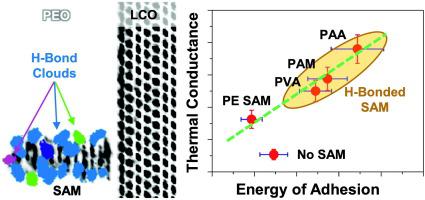当前位置:
X-MOL 学术
›
Mater. Des.
›
论文详情
Our official English website, www.x-mol.net, welcomes your
feedback! (Note: you will need to create a separate account there.)
Improving thermal conduction across cathode/electrolyte interfaces in solid-state lithium-ion batteries by hierarchical hydrogen bond network
Materials & Design ( IF 7.6 ) Pub Date : 2020-09-01 , DOI: 10.1016/j.matdes.2020.108927 Jinlong He , Lin Zhang , Ling Liu
Materials & Design ( IF 7.6 ) Pub Date : 2020-09-01 , DOI: 10.1016/j.matdes.2020.108927 Jinlong He , Lin Zhang , Ling Liu

|
Abstract Effective thermal management is an important issue to ensure safety and performance of lithium-ion batteries. Fast heat removal is highly desired but has been obstructed by the high thermal resistance across cathode/electrolyte interface. In this study, self-assembled monolayers (SAMs) are used as the vibrational mediator to tune interfacial thermal conductance between an electrode, lithium cobalt oxide (LCO), and a solid state electrolyte, polyethylene oxide (PEO). Embedded at the LCO/PEO interface, SAMs are specially designed to form hierarchical hydrogen-bond (H-bond) network with PEO. Molecular dynamics simulations demonstrate that all SAM-decorated interfaces show enhanced thermal conductance and dominated by H-bonds types. The incorporation of poly(acrylic acid) (PAA) SAM drastically enhances interfacial thermal conductance by approximately 211.69%, largely due to the formation of a strong H-bond, -COOH···:O, between PAA and PEO. Even with weaker H-bonds such as -OH···:O, it still outperforms the pristine interface as well as interfaces decorated with non-H-bonded SAMs, e.g. PE. Such improvement is attributed to the unique hierarchical H-bond network at the interface, which removes discontinuities in temperature field, straighten SAM chains, make materials strongly adhere, and couple the vibrational modes of materials. The study is expected to guide surface engineering for more effective thermal management in lithium-ion batteries.
中文翻译:

通过分层氢键网络改善固态锂离子电池中阴极/电解质界面的热传导
摘要 有效的热管理是确保锂离子电池安全和性能的重要问题。快速散热是非常需要的,但由于阴极/电解质界面的高热阻而受到阻碍。在这项研究中,自组装单层 (SAM) 用作振动介质来调节电极、钴酸锂 (LCO) 和固态电解质聚环氧乙烷 (PEO) 之间的界面热导。SAM 嵌入 LCO/PEO 界面,专门设计用于与 PEO 形成分层氢键(H 键)网络。分子动力学模拟表明,所有 SAM 修饰的界面都显示出增强的热导性,并以 H 键类型为主。聚(丙烯酸)(PAA)SAM 的加入使界面热导率大幅提高了约 211.69%,这主要是由于在 PAA 和 PEO 之间形成了强氢键 -COOH...:O。即使使用较弱的 H 键,例如 -OH...:O,它仍然优于原始界面以及用非 H 键的 SAM 装饰的界面,例如 PE。这种改进归因于界面处独特的分层氢键网络,它消除了温度场中的不连续性,拉直了 SAM 链,使材料牢固粘附,并耦合了材料的振动模式。该研究有望指导表面工程在锂离子电池中进行更有效的热管理。即使使用较弱的 H 键,例如 -OH...:O,它仍然优于原始界面以及用非 H 键的 SAM 装饰的界面,例如 PE。这种改进归因于界面处独特的分层氢键网络,它消除了温度场中的不连续性,拉直了 SAM 链,使材料牢固粘附,并耦合了材料的振动模式。该研究有望指导表面工程在锂离子电池中进行更有效的热管理。即使使用较弱的 H 键,例如 -OH...:O,它仍然优于原始界面以及用非 H 键的 SAM 装饰的界面,例如 PE。这种改进归因于界面处独特的分层氢键网络,它消除了温度场中的不连续性,拉直了 SAM 链,使材料牢固粘附,并耦合了材料的振动模式。该研究有望指导表面工程在锂离子电池中进行更有效的热管理。并耦合材料的振动模式。该研究有望指导表面工程在锂离子电池中进行更有效的热管理。并耦合材料的振动模式。该研究有望指导表面工程在锂离子电池中进行更有效的热管理。
更新日期:2020-09-01
中文翻译:

通过分层氢键网络改善固态锂离子电池中阴极/电解质界面的热传导
摘要 有效的热管理是确保锂离子电池安全和性能的重要问题。快速散热是非常需要的,但由于阴极/电解质界面的高热阻而受到阻碍。在这项研究中,自组装单层 (SAM) 用作振动介质来调节电极、钴酸锂 (LCO) 和固态电解质聚环氧乙烷 (PEO) 之间的界面热导。SAM 嵌入 LCO/PEO 界面,专门设计用于与 PEO 形成分层氢键(H 键)网络。分子动力学模拟表明,所有 SAM 修饰的界面都显示出增强的热导性,并以 H 键类型为主。聚(丙烯酸)(PAA)SAM 的加入使界面热导率大幅提高了约 211.69%,这主要是由于在 PAA 和 PEO 之间形成了强氢键 -COOH...:O。即使使用较弱的 H 键,例如 -OH...:O,它仍然优于原始界面以及用非 H 键的 SAM 装饰的界面,例如 PE。这种改进归因于界面处独特的分层氢键网络,它消除了温度场中的不连续性,拉直了 SAM 链,使材料牢固粘附,并耦合了材料的振动模式。该研究有望指导表面工程在锂离子电池中进行更有效的热管理。即使使用较弱的 H 键,例如 -OH...:O,它仍然优于原始界面以及用非 H 键的 SAM 装饰的界面,例如 PE。这种改进归因于界面处独特的分层氢键网络,它消除了温度场中的不连续性,拉直了 SAM 链,使材料牢固粘附,并耦合了材料的振动模式。该研究有望指导表面工程在锂离子电池中进行更有效的热管理。即使使用较弱的 H 键,例如 -OH...:O,它仍然优于原始界面以及用非 H 键的 SAM 装饰的界面,例如 PE。这种改进归因于界面处独特的分层氢键网络,它消除了温度场中的不连续性,拉直了 SAM 链,使材料牢固粘附,并耦合了材料的振动模式。该研究有望指导表面工程在锂离子电池中进行更有效的热管理。并耦合材料的振动模式。该研究有望指导表面工程在锂离子电池中进行更有效的热管理。并耦合材料的振动模式。该研究有望指导表面工程在锂离子电池中进行更有效的热管理。











































 京公网安备 11010802027423号
京公网安备 11010802027423号